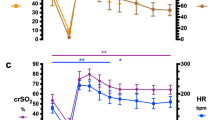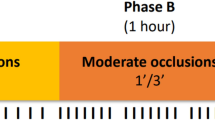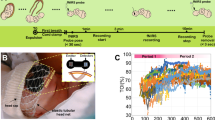Abstract
Adequate cerebral perfusion is necessary to preserve cerebral O2 supply in order to maintain brain cell function. Our aim was to assess the influence of gestational age on the response of cerebral hemodynamics to hypoxemia and to determine thresholds of cerebral O2 supply for preservation of brain cell function in preterm born lambs. Lambs were delivered by hysterotomy at 141 (n=5), 134 (n=5) or 127 (n=7) days of gestation. Decreases in arterial oxygen content (CaO2) were induced by stepwise reduction of the fraction of O2 in inspired air (FiO2). Mean arterial blood pressure (MABP), carotid artery blood flow (Qcar), and electrocortical brain activity as a measure of brain cell function, were continuously recorded. Cerebral arterial blood gases were analyzed at the end of each hypoxemic level to calculate CaO2 and cerebral O2 supply. In contrast to 141-day lambs, MABP could not be maintained in 134-day and 127-day lambs at levels of severe hypoxemia. Increases in Qcar were observed at levels of moderate hypoxemia in all gestational age-groups. Albeit Qcar increased further at levels of severe hypoxemia in the 141-day lambs, Qcar declined under these conditions in the 134-day and 127-day lambs. The threshold of cerebral O2 supply for the preservation of brain cell function was however similar in all gestational age-groups (1.7 ml/min). It is concluded that the ability to maintain cerebral function during hypoxemia depends upon the ability to preserve cerebral O2 supply by means of cerebral hemodynamic compensatory mechanisms, which are not fully matured until 96% of gestation.



Similar content being viewed by others
References
Akeson J, Bjorkman S, Messeter K, Rosen I, Helfer M (1993) Cerebral pharmacodynamics of anaesthetic and subanaesthetic doses of ketamine in the normoventilated pig. Acta Anaesthesiol Scand 37:211–218
Altman DG (1999) Regression. In: Practical statistics for medical research. Chapman and Hall, London, pp 299–306
Anwar M, Agarwal R, Rashduni D, Weiss HR (1996) Effects of hemorrhagic hypotension on cerebral blood flow and perfused capillaries in newborn pigs. Can J Physiol Pharmacol 74:157–162
Arnold BW, Martin CG, Alexanderm BJ, Chen T, Fleming LR (1991) Autoregulation of brain blood flow during hypotension in infant lambs. Pediatr Res 29:110–115
Bennhagen RG, Weintraub RG, Lundstrom NR, Svenningsen NW (1998) Hypoxic-ischaemic encephalopathy is associated with regional changes in cerebral blood flow velocity and alterations in cardiovascular function. Biol Neonate 73:275–286
Bloom RS (1992) Delivery room resuscitation of the newborn. In: Fanaroff AA, Martin RJ (eds) Neonatal-perinatal medicine diseases of the fetus and infant. Mosby Year Book, St. Louis, pp 301–324
Burrows FA, Norton JB, Fewel J (1986) Cardiovascular and respiratory effects of ketamine in the neonatal lamb. Can Anaesth Soc J 33:10–15
Calvert SA, Widness JA, Oh W, Stonestreet BS (1990) The effects of acute uterine ischemia on fetal circulation. Pediatr Res 27:552–556
Carlsson C, Hagerdal M, Siesjo BK (1975) Increase in cerebral oxygen uptake and blood flow in immobilization stress. Acta Physiol Scand 95:206–208
Connell J, De Vries L, Oozeer R, Regev R, Dubowitz LM, Dubowitz V (1988) Predictive value of early continuous electroencephalogram monitoring in ventilated preterm infants with intraventricular hemorrhage. Pediatrics 82:337–343
Den Ouden L, Hille ETM, Verrips E, Sneeuw K, Verloove-Vanhorick SP (2001) Preterm birth, sentence to life? Pediatr Res 49:272
Gavilanes AWD, Vles JSH, Von Siebenthal K, Reulen JP, Nieman FH, Van Sprundel R, Blanco CE (2001) Electrocortical brain activity, cerebral haemodynamics and oxygenation during progressive hypotension in newborn piglets. Clin Neurophysiol 112:52–59
Gratton R, Carmichael L, Homan J, Richardson B (1996) Carotid arterial blood flow in the ovine fetus as a continuous measure of cerebral blood flow. J Soc Gynecol Invest 3:60–65
Gunn AJ, Parer JT, Mallard EC, Williams CE, Gluckman PD (1992) Cerebral histologic and electrocorticographic changes after asphyxia in fetal sheep. Pediatr Res 31:486–491
Hack M, Friedman H, Fanaroff AA (1996) Outcomes of extremely low birth weight infants. Pediatrics 98:31–937
Harris AP, Helou S, Gleason CA, Traystman RJ, Koehler RC (2001) Fetal cerebral and peripheral circulatory responses to hypoxia after nitric oxide synthase inhibition. Am J Physiol 281:R381–R390
Laptook AR, Stonestreet BS, Oh W (1983) Brain blood flow and O2 delivery during hemorrhagic hypotension in the piglet. Pediatr Res 17:77–80
Laptook AR, Corbett RJ, Nguyen HT, Peterson J, Nunnally RL (1988) Alterations in cerebral blood flow and phosphorylated metabolites in piglets during and after partial ischemia. Pediatr Res 23:206–211
Lou HC, Lassen NA, Friis-Hansen B (1979) Impaired autoregulation of cerebral blood flow in the distressed newborn infant. J Pediatr 94:118–121
Meadow W, Rudinsky B, Raju T, John E, Fornell L, Shankararao R (1999) Correlation of flow probe determinations of common carotid artery blood flow and internal carotid artery blood flow with microsphere determinations of cerebral blood flow in piglets. Pediatr Res 45:324–330
Nijland R, Ringnalda B, Jongsma HW, Oeseburg B, Zijlstra WG (1994) Measurement of oxygen saturation by multiwavelength analyzer influenced by interspecies differences. Clin Chem 40:1971
Norwitz ER, Robinson JN (2001) A systematic approach to the management of preterm labor. Semin Perinatol 25:223–235
Odden JP, Farstad T, Roll EB, Hall C, Bratlid D (1994) Cerebral blood flow autoregulation after moderate hypoxemia in the newborn piglet. Biol Neonate 65:367–377
O'Neill JT, Golden SM, Franklin GA, Alden ER (1994) Cerebral vascular response to hemorrhagic hypotension in newborn lambs: the influence of developing anemia. Proc Soc Exp Biol Med 205:132–139
Papile LA, Rudolph AM, Heymann MA (1985) Autoregulation of cerebral blood flow in the preterm fetal lamb. Pediatr Res 19:159–161
Raju TN (1992) Some animal models for the study of perinatal asphyxia. Biol Neonate 62:202–214
Richardson BS, Carmichael L, Homann J, Patrick JE (1992) Electrocortical activity, electroocular activity, and breathing movements in fetal sheep with prolonged and graded hypoxemia. Am J Obstet Gynecol 167:553–558
Richardson BS, Carmichael L, Homan J, Patrick JE (1993) Cerebral oxidative metabolism in fetal sheep with prolonged and graded hypoxemia. J Dev Physiol 19:77–83
Szymonowicz W, Walker AM, Cussen L, Cannata J, Yu VY (1988) Developmental changes in regional cerebral blood flow in fetal and newborn lambs. Am J Physiol 254:H52–H58
Van Bel F, Dorrepaal CA, Benders MJ, Zeeuwe PE, Van de Bor M, Berger HM (1993) Changes in cerebral hemodynamics and oxygenation in the first 24 hours after birth asphyxia. Pediatrics 92:365–372
Van Bel F, Bartelds B, Teitel DF, Rudolph AM (1995) Effect of indomethacin on cerebral blood flow and oxygenation in the normal and ventilated fetal lamb. Pediatr Res 38:243–250
Van de Bor M, Den Ouden L (2001) School perrformance in children with and without periventricular-intraventricular hemorrhage (PIVH) at 10 and 14 years of age. Pediatr Res 50:280
Van de Bor M, Walther FJ (1991) Cerebral blood flow velocity regulation in preterm infants. Biol Neonate 59:329–335
Veen S, Ens-Dokkum MH, Schreuder AM, Verloove-Vanhorick SP, Brand R, Ruys JH (1991) Impairments, disabilities, and handicaps of very preterm and very-low-birthweight infants at five years of age. The Collaborative Project on Preterm and Small for Gestational Age Infants (POPS) in The Netherlands. Lancet 338:33–36
Walther FJ, Den Ouden AL, Verloove-Vanhorick SP (2000) Looking back in time: outcome of a national cohort of very preterm infants born in The Netherlands in 1983. Early Hum Dev 59:175–191
Acknowledgements
We thank Alex Hanssen and Theo Arts, Central Animal Laboratory Nijmegen, for their advice and surgical assistance.
Author information
Authors and Affiliations
Corresponding author
Rights and permissions
About this article
Cite this article
Van Os, S., Klaessens, J., Hopman, J. et al. Preservation of electrocortical brain activity during hypoxemia in preterm lambs. Exp Brain Res 151, 54–59 (2003). https://doi.org/10.1007/s00221-003-1469-6
Received:
Accepted:
Published:
Issue Date:
DOI: https://doi.org/10.1007/s00221-003-1469-6




